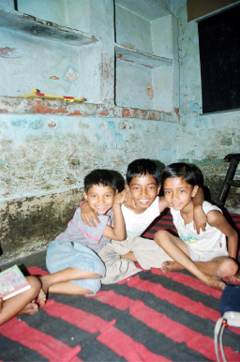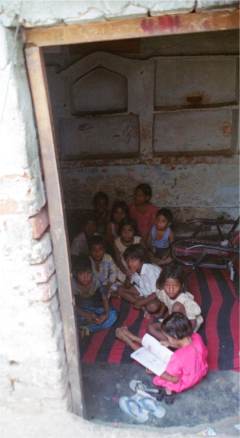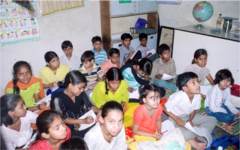A decrepit door opens into a tiny classroom in one corner of a slum settlement in Mangolpuri in north-west Delhi. A black sheet hanging from the wall passes off for a blackboard, but it's difficult to discern letters or numerals in the windowless room, which is dark despite the harsh sun outside. A fraying chair stands to the front of the room, presumably for the teacher who has not yet arrived, though it's almost an hour past 9 am, when lessons are supposed to begin. There is no electricity, no water, benches or toilets, and no signs of students either.

![]() A light moment in the dark classroom at Mangolpuri.
Pic: Deepa A.
A light moment in the dark classroom at Mangolpuri.
Pic: Deepa A.
Outside the shack, Sompal Singh, a middle-aged electrician who also doubles as the slum's community leader, attributes the absence of students to the summer heat. "The room doesn't have power," he explains. "There are no facilities in the classroom. We had to provide the chair for the teacher to sit."
This one-room Non-Formal Education centre is run by a non-governmental organisation in Delhi as part of the Central Government's Sarva Shiksha Abhiyan scheme, meant to ensure all children are in school. Non-formal education is purportedly an alternative schooling model for children who have been forced out of the mainstream education system, mostly because of their socio-economic circumstances. But as is clear from the centre at Mangolpuri, where a teacher materialises after nearly two hours of waiting, and then only to round up children and put up a show of numbers, even education sometimes appears to be too lofty a goal for these children. Compared to their counterparts who can afford to study at private schools, children at many non-formal education centres seem to be at the receiving end of a discriminatory system that's insensitive to their requirements.
As Kailash Satyarthi, chairperson of a Delhi-based non-government organisation working with children called Bachpan Bachao Andolan, says, "There is good quality education for rich children, poor quality of education for children who aren't rich, and the worst kind of education in the name of non-formal centres for oppressed children. This has created inequality and disparity."
NFE: The story behind the three letters
Non-formal Education (NFE) centres are mainly meant for children who are not enrolled in the right age at school, says Bupinder Zutshi, professor at the Jawaharlal Nehru University, Delhi, who has written extensively on education facilities for child labourers and children on the streets. "Unfortunately, a number of children are not enrolled in the right age [that is, six years for Class I], because they are working. As they get older, it's not possible to begin their education by enrolling them in Class I. So they have to be provided with the capacities to join a regular school, in a class suitable for their age," he explains.
The central government is involved in two types of non-formal centres: one run under SSA, and the other under the National Child Labour Project (NCLP). Under both the schemes, NGOs run the centres with funding from the government.
The centres run under SSA are meant for those who do not have access to school, such as children in hilly areas. The non-formal education scheme itself was started in the 70s and this was later linked to SSA when the latter was started in 2001. Today, the non-formal centres are spread across 25 states, covering 74 lakh children, according to figures in the Central Government's education ministry website.
The child labour project is run by the labour ministry and today spans 4,000-odd schools and over 4 lakh children, according to statistics in the ministry's website. This project was started in the late eighties to provide child labourers rescued from hazardous industries with non-formal education. The National Policy of Education-1986 (NPE) also seconded the setting up of such non-formal schools by involving voluntary agencies and Panchayati Raj institutions. Children can also secure vocational training, supplementary nutrition, regular health care and a stipend under the project.
Under the SSA scheme, NGOs are given Rs 845 per child per annum for NFE centres. The NCLP scheme is more generous with funds and an amount of Rs 100 per month is even allotted as stipend for each child in a non-formal centre. The scheme's annual budget for one school works to about Rs 2.5 lakh.
Despite these two schemes, non-formal education doesn't seem to have achieved its goals. As R Govinda, senior fellow and head of the school and non-formal education unit at the National Institute of Educational Planning and Administration, Delhi, puts it, "Internationally, NFE means literacy and adult education programmes, and the terminology is used in a larger sense." In India, however, no original work is being done in the area, he says. "Here, non-formal centres are the same as schools, except that they don't have buildings. The teachers are paid less [at NFE centres], and the students are taught less," he adds.
Experts say that a majority of the children at NFE centres do not go on to join formal schools, thereby defeating the very purpose with which alternative education models were set up. For instance, according to a report prepared in 2001 by Zutshi for the National Human Rights Commission, on the functioning of non-formal education centres in the carpet weaving and glass-bangle making belt of Mirzapur-Bhadhoi and Ferozabad in Uttar Pradesh, nearly 50-60 percent of the children were found to have dropped out of Ferozabad's NFE centres. Says Govinda, "The main concern is that those in bridge courses don't join mainstream schools. Even if they do, they drop out of schools, either because they are unable to adjust to the school atmosphere or because of lack of facilities in the schools themselves."
Why NFE centres get poor marks
The reasons for children dropping out of NFE centres are many: poor teachers, lack of facilities and funds, lack of textbooks and, inadequate community involvement. Take, for instance, the Mangolpuri centre, run by an NGO called A V Balika Trust. Sangeeta Swarth, the teacher for the morning shift, is a final-year arts student who is paid Rs 1,500 per month. She says the NGO gave her training for a few days when she started working for them four years ago.

![]() The class at Mangolpuri as seen from outside.
Pic: Deepa A.
The class at Mangolpuri as seen from outside.
Pic: Deepa A.
However, Zutshi points out that most NGOs do not train teachers adequately. In fact, no funds are set aside for teacher training in non-formal education. "What I saw in Uttar Pradesh was that a majority of the NGOs were appointing people known to them or relatives of staff. There are no guidelines on selecting teachers for the centres," he says. Most NFE centres appoint those in the community who have studied till the 10th or 12th standard as teachers. To make amends, it's imperative that state or district agencies for teacher training, such as the State Council for Educational Research and Training, at least train the teachers selected by the NGOs, says Zutshi.
Not only are the teachers not qualified, but they are also paid poorly. In urban areas, they earn Rs 1,500 per month, but their salaries can be much lower in rural areas. Despite these shortcomings, teachers are expected to handle 40 students in each centre set up under SSA. Rakesh Sharma, an activist working in the Mangolpuri area, says, "Thirty to one is considered the ideal student-teacher ratio in government schools. But NFE centres are asked to have 40 students in each class. Why should the number of students be higher when the teachers have a more difficult job at the centres?" It's tougher for the NFE teachers to supervise children as parents often pull the children out of the class for work, adds Swarth.
Ramashree Yadav, the Balika Trust coordinator for the Mongalpuri area, presents a veritable list of problems that the NGO faces while running its 62 NFE centres in the area. "There is not much community involvement, so it's difficult to mobilise children. Funds are also a problem. We have taken places on rent, but there isn't much by way of infrastructure," he says.
The curriculum followed in non-formal centres if there's a curriculum to speak of is also a grey area. Many centres use books that are easily available in the market instead of the texts prescribed in government schools, says Zutshi. Therefore, children's competency levels are seldom in the same range as that of their counterparts in a regular school.
The duration of the classes at NFE centres also leave a lot to be desired. "In many cases, classes are run for 30 minutes instead of three hours," says Rakesh Senger, advocacy coordinator for BBA and the South Asian Coalition on Child Servitude.
Education would have to be linked to other factors such as poverty and employment, says Bupinder Zutshi, professor at the Jawaharlal Nehru University.
"This is a multi-level issue you have to provide employment and food support to families. Education cannot be looked at in isolation," says Zutshi.

•
Needs of today, hopes of tomorrow
•
Are girl students safe
Another area of concern is vocational training. The vocational skill sets that the children are taught in NFE centres are not up to the mark, and rarely serve in helping them find employment later. As activists point out, craft is often taught in the name of vocational training in many NFE centres, though children can't look at making bead necklaces or stuffed toys as career options.
Girls and NFE centres
In Mangolpuri, Khushboo Khan, a tenth standard pass girl who used to teach at the non-formal education centre, says that parents are most hesitant to send girls to the class. Adds Sompal Singh, "They take care of siblings at home, or if their parents work, the girls run the homes."
While many NFE centres claim to have more girls than boys, especially in urban areas, the fact remains that girls don't have the same opportunities as boys.
Govinda, for instance, recalls an incident when he was in Rajasthan's Bikaner district for a school-mapping exercise. Child marriage was common in the district, and the villagers were clear that they would not send their bahus to school, though the girls were of school-going age. However, the elders in the village expressed an interest when they were told about the benefits of literacy; for instance, their daughters married to families in other villages would be able to keep in touch with them over mail. They still didn't want to send their girls to school, but an option where they could learn without attending school was acceptable, says Govinda. However, the current non-formal system does not recognise these pluralistic realities, he says, adding that no brainstorming is being done to find solutions. "We need alternative methods for educating them, we have to see how to break into their cultural context," he adds. He feels that NGOs and the government must work out solutions that will have the support of the community.
Cutting through red tape
The bureaucratic problems involved in running NFE centres are so many that several NGOs simply refuse to be part of the process. BBA, for instance, initially tried running a centre under NCLP in Agra, U.P. "The NCLP budget for a centre provides for hiring a clerk," says Senger. "But the labour department would insist on making use of the same clerk." When they protested, the labour department started troubling the organisation, complaining among other things that they did not have the requisite number of children to run a centre. "Ultimately, we decided to shut it down," says Senger.
The fact that there are two kinds of NFE centres, run by two different ministries, also seems to have lead to problems. "There is no collaboration between the labour ministry and the education department. Sometimes, you will find that the same area has everything a regular school, a NFE centre under SSA, and one under NCLP," says Senger. The labour ministry also does not have the expertise required for managing an education project, warn experts.
There is also no monitoring system in place to assess the kind of work done by NGOs. Field officers who are expected to keep a check on quality emphasise on numbers and are often satisfied with registers pointing to the requisite number of children in class. Experts say that there is no follow-up action, and not even an attempt is made to see how many children in NFE centres go on to join and continue in mainstream school.
A little good work being done, still
Govinda, while pointing to the poor non-formal education system in the country, also acknowledges that there are a few NGOs doing good work. "Even if the lives of five percent change because of this intervention, that's a good enough contribution," he says.

![]() An alternative education class run by Prayas in progress at Sangam Vihar.
Pic: Deepa A.
An alternative education class run by Prayas in progress at Sangam Vihar.
Pic: Deepa A.
Prayas, a NGO based in Delhi, runs 75 centres under SSA, and claims to enroll almost all the children in its NFE centres in government schools. Naushad A Khan, senior manager (education), at the organisation, however, adds that the number of children continuing up to the eighth standard is possibly lower.
Mini Yadav, a 26-year-old teacher at Prayas' Sangam Vihar centre, says that as the children hail from poor families, parents often call the boys out of class for work. "But we were told during the training that we should teach them on their own terms. That is, as and when they are free, we take classes," she says. From her centre, 95 percent of the children are subsequently enrolled in government schools, she claims, though she admits that students do drop out from formal schools due to reasons ranging from inadequate attention from teachers to corporal punishment, which is common in municipal schools.
Prayas conducts monthly refresher courses for teachers and organises meetings wherein they can discuss their problems and achievements, says Simran Kaur, assistant manager (education), Prayas. This has helped in building an enduring relationship between the teachers, the NGO and the community.
Making the grade
Whatever be the methods used for teaching or learning, merely enrolling students in NFE centres without accounting for their future education is meaningless, stresses Zutshi. To change the situation, education would have to be linked to other factors such as poverty and employment, says the professor. "This is a multi-level issue you have to provide employment and food support to families. Education cannot be looked at in isolation," he adds.
A popular idea today is that non-formal education should be abolished, as all children have the right to the same kind of education. Many also believe that NFE centres do not necessarily put an end to child labour, as parents send children to class for a few hours and then to work. However, others counter that the centres have a vital role to play. Yadav, for instance, says that his trust works in areas where people have been resettled after demolitions. "Many of them have migrated from other states, and they have had to move again. It's difficult for them to put children in regular schools as they have had to shift time and again," he says. Many of the children work, either helping out at home or outside, and find the fixed timings of a regular school problematic, he explains. The flexible timings of NFE centres appeal to children from such families, he adds.
But, unless the learning and teaching in NFE centres improve, it's clear that children are being cheated out of their rightful share of quality education. As Kailash Satyarthi says, all alternative education models should be run on the condition that the children will eventually join mainstream schools. Anything less would indicate only the state's abdication of its responsibilities of equitable, universal education.
